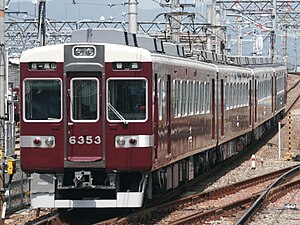Hankyu Arashiyama Line
| Hankyu Arashiyama Line | |
|---|---|
 Arashiyama Line train (6300 series) | |
| Overview | |
| Native name | 阪急嵐山線 |
| Locale | Kansai |
| Termini |
|
| Stations | 4 |
| Service | |
| Operator(s) | Hankyu Railway |
| Depot(s) | Katsura |
| Rolling stock | 6300 series EMU 7300 series EMU(under substitution) 8300 series EMU(under substitution) |
| Technical | |
| Line length | 4.1 km (2.5 mi) |
| Number of tracks | Single |
| Track gauge | 1,435 mm (4 ft 8+1⁄2 in) |
| Electrification | 1,500 V DC, overhead line |
| Operating speed | 70 km/h (43 mph) |
The Hankyu Arashiyama Line (嵐山線, Arashiyama-sen) is a railway line in Kyoto, Japan, operated by private railway operator Hankyu Railway. It connects Katsura and Arashiyama on the west side of the city, linking the area along the line to the Hankyu Kyoto Main Line that extends east to central Kyoto and south to Osaka. The line is 4.1 km long.[1]
Trains on the line mainly use 4-car Hankyu 6300 series electric multiple unit trains, which were originally built for limited express services on the main line from 1975 and refurbished for Arashiyama Line services from 2009.
History
[edit]The line opened as 1435mm gauge dual track electrified at 1500 VDC in November 1928.
One line of the dual track was removed in 1944 for metal collection as part of the Japanese war effort. Crossing loops at both intermediate stations were built in 1950.[2]
Stations
[edit]| No. | Station | Japanese | Distance (km) | Transfers | Places of interest |
|---|---|---|---|---|---|
| HK-81 | Katsura Station | 桂 | 0.0 | ||
| HK-96 | Kami-Katsura Station | 上桂 | 1.4 | Nishikyo Ward Office, Saihō-ji Temple | |
| HK-97 | Matsuo-taisha Station | 松尾大社 | 2.8 | Matsunoo Shrine, Umemiya Shrine | |
| HK-98 | Arashiyama Station | 嵐山 (嵯峨野) | 4.1 | Arashiyama Park |
All four stations on the line are in Nishikyo-ku, Kyoto. While the entire line is single track, both the intermediate stations are equipped with crossing loops.
References
[edit]This article incorporates material from the corresponding article in the Japanese Wikipedia
- ^ JTB Timetable March 2010 issue, p. 841
- ^ Keihanshin Kyūkō Dentetsu (1957). 京阪神急行電鉄五十年史 [Fifty-Year History of Keihanshin Kyūkō Dentetsu] (in Japanese). p. 55.


 French
French Deutsch
Deutsch